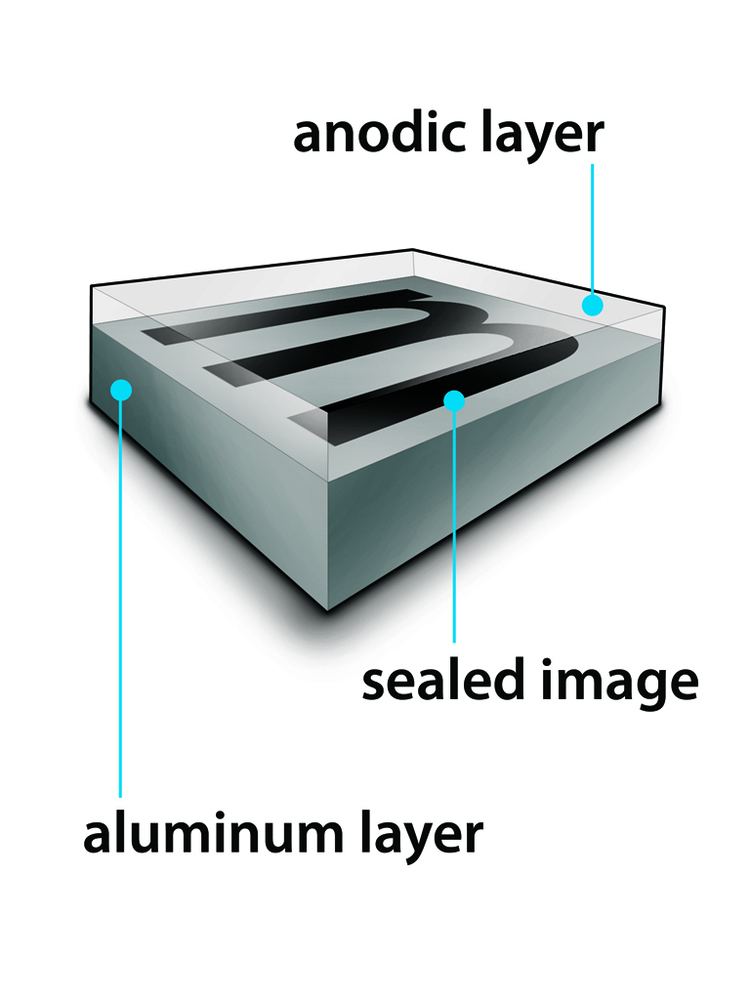 | ||
Photosensitive anodized aluminum, also referred to as photo anodized aluminum, photo metal or Metalphoto, utilizes the porous nature of unsealed anodized aluminum to create a sub-surface image, either through exposure and development of an anodic layer impregnated with silver compounds (Type 1), much like traditional black & white photography, or through use of a photomask (Type 2) in which the image is created through a variety of means, including chemical etching, color addition or color subtraction.
Contents
Technology
Type 1 photosensitive anodized aluminum is anodized aluminum that has been impregnated with a silver compound which, when exposed to a light source, creates an activated latent image. Upon development and fixing a black, silver-based image is formed inside of the metal. Type 1 photosensitive anodized aluminum is then sealed in boiling water similarly to common anodized aluminum. Sealing hydrates the aluminum oxide surface, trapping the image beneath the anodized layer. The combined benefits of UV stability and the high image resolution of silver photography along with the abrasion and corrosion resistance of anodized aluminum are used to advantage in applications where permanent product identification is critical such as equipment nameplates, IUID barcode labels, outdoor signage, safety/warning plates, machine control panels and fine art.
Type 2 photosensitive anodized aluminum is typically coated with a photo resist, which may be of either the positive or negative type. Exposure of the photo resist through a negative and its subsequent development creates areas on the plate that are either protected by the resist or exposed to the effects of the dye, bleach, or etchant that are used to create the contrasting mark. Type 2 photosensitive anodized aluminum must be sealed just like Type 1. Common use for Type 2 applications are those where color (other than black) is desired on the finished product. The dyes used to create colored Type 2 plates can vary significantly in their heat and color fastness, so are often limited to indoor or short-term outdoor usage. Note that colored dyes can also be incorporated into Type 1 photosensitive anodized aluminum.
History
Type 1 photosensitive anodized aluminum was developed in 1950 by Horizons Research Incorporated. Since its introduction, several companies have attempted to manufacture photosensitive anodized aluminum, although consistent manufacturing quality has been a barrier to entry. Today, Type 1 photosensitive anodized aluminum is manufactured by Horizons Imaging Systems Group under the Metalphoto® brand name.
Industrial and Military Specification
Photosensitive anodized aluminum was qualified to Federal Specification GG-P-455 in 1965, a document that outlines the performance of Type 1 and Type 2 photosensitive anodized aluminum. Since qualification to GG-P-455, photosensitive anodized aluminum has been specified by many military, government and industrial organizations, including:
In 2012 the Naval Surface Warfare Center (NSWC), Corona Division conducted tests on several IUID materials and found that Metalphoto photosensitive anodized aluminum achieved the highest score on more environmental survivability tests than any other IUID label material evaluated. Type 1 photosensitive anodized aluminum is certified to several military and federal specifications:
Notable Uses
Over the years, photosensitive anodized aluminum has been used in several notable applications, including:
